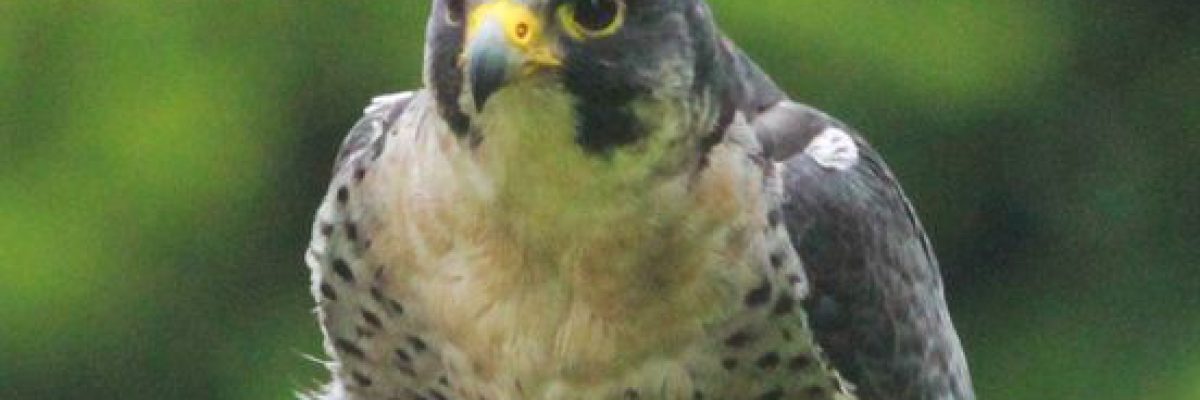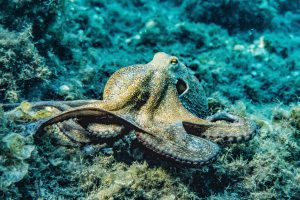The Falcons are some of the most impressive bird species, thanks to their incredible visibility, courageousness, and dive speed (between 160 – 390 Kmh). They may be the smallest of all diurnal raptors, but they are the most territorial and fierce, so in their mating season, they can banish every unwanted intruder from their territory.
General description
Their body length is between 20 -26 cm, wind span between 37 – 160 cm, and weight between 42 – 1,700 grams only (the females are 20 – 30% larger than the males).
The biggest falcon is the Gyrfalcon (Falcorusticolus) from the Arctic region, its length is between 45 -55 cm.
The smallest falcon is the Merlin (Polihirrax semitorauatus), its body length reaches up to only 20 cm, and its weight is between 40 – 85 grams. From a distance, it looks similar to a typical Shrike.
Sexual dimorphism happens only in certain species, mainly in the smaller species, such as the Common Kestrel, Red-Footed Falcon, Lesser Kestrel, and Merlin. While in the larger species, such as Saker Falcon, Lanner Falcon, and Peregrine Falcon, there is no sexual dimorphism. The falcons’ wings are relatively long compared to the length of their body and have pointed ends (less visible with larger falcons). The larger falcons’ tails are shorter compared to the smaller falcons.
Generally, their chest is more developed than other diurnal raptors due to their massive flight muscles. Their upper beak has a bulge, similar to a tooth, which is characteristic of falcons and helps them break their prey’s neck and paralyze it immediately. Like other birds of prey, the falcon has a small sharp pointy beak adjusted for smaller prey. Only a few species, such as the Lanner Falcon and Gyrfalcon, have a variety of colorful feathers. The Peregrine Falcon has a complex nostril structure fixed in a yellow waxy matter to protect its lungs when diving at great speed in the air (A type of oil drop in their retina’s light receptors helps protect their big sunken eyes).
Classification and names
This family has two subfamilies: the Falconinae and the Polyborinae (there are debates about whether the Phalcoboenus subfamily also belongs to the family). There are 38 species of falcons worldwide (11 in Israel) belonging to 10 genera.
According to research, falcons most likely appeared around 24 million years ago, much later than the hawks (Accipitridae) (9 extinct species were discovered, most of them from Argentina). Genetic study reveals that shared characteristics between them and hawks are due to a convergence process (“convergence of characteristics” because of a similar lifestyle). 60% of all falcons globally are from the genus Falco.
The Peregrine Falcon has the most subspecies (19), which are different from each other in their color, appearance, and distribution.
The meaning of their name, derived from their Latin scientific name, is “sickled”, which describes well their very sickled beaks and claws. Their Hebrew name is ambiguous and mentioned only once in the bible (not as a bird’s name), and the biblical hawk may be the falcon, as the falcon is much more prominent than the hawk.
Global distribution
The falcons live on all continents but Antarctica. Most of them are found in tropical regions. Out of 38 species – 9 species are African, 12 species are Eur-Asian, 4 species are east Asian, 7 species are American, 4 species are Australian, and 2 species are endemic to Mauritius and Seychelles Islands.
Distribution in Israel
11 species of falcons are found in Israel (out of 12 species found in Eur-Asia), a third of the total global species. Six species nests in Israel (not including the Peregrine Falcon, which tried to next in Israel a few times with no success, even in Tel Aviv). Saker Falcon (a very rare species, under the threat of extinction in Israel) and Merlin pass the winters in Israel (especially in the west of the Negev region), Eurasian Hobby (very common), and Lesser Kestrel (under extreme risk of extinction in Israel) pass the summers in Israel. Red – Footed Falcon and Eleonora’s Falcon only migrate through Israel. In the desert of Israel, the Sooty Falcon, Lanner Falcon (in the past decades, it was also returned to the Carmel region to nest), and Barbary Falcon nest. Eleonora’s Falcon (Found mainly on the Mediterranean coast, including Morocco, Tunisia, and the Canary Islands) passes its winters in Madagascar, usually. It migrates above Israel until mid-summer (a rough estimation claims only 13,500 pairs of them are left).
Habitats
The family is very active in all habitats, snowy and the desert area included, but they are mainly found in forests, coasts, rocky wadis, fallow fields and agriculture fields, humid areas, and of course, urban areas (Peregrine Falcon and Common Kestrel nest in buildings as well as cliffsides). Common Kestrels and Lesser Kestrels choose to sometimes nest in artificial nest boxes alongside humans.
Food and feeding methods
The falcons are meat eaters, and there is usually a food preference based on the specie and sex. The Common Kestrel clearly prefers voles, the Lesser Kestrel clearly prefers bugs, the Barbary Falcon prefers desert birds, the Eleonora’s Falcon prefers migrating birds, the Eurasian Hobby prefers singing birds, and the Saker Falcon prefers squirrels and rabbits. The primary food of the Gyrfalcon, that is active in the Arctic region (he is camouflaged with white feathers), is a type of grouse. The Milvago prefers hunting bees and wasps, and the Laughing Falcon (Herpetotherescahinnans) prefers hunting snakes. It is essential to mention that all falcons do not feed from carcasses (except certain species of Caracaras, which eat carcasses and courageously kidnap chicks of colonial sea birds).
Falcons are mainly active in the early morning hours and before sunset, following the hours their prey is most active. The Common Kestrel is active all day long. Most hunts take place from an eminent viewpoint or the air, whether diving down to the ground or catching prey midair. The Peregrine Falcon can sometimes just touch its prey’s chest bones lightly with its claws in midair while diving down very fast, in order for the prey to be paralyzed and crush to the ground. Some prey is brought to the dining table for further treatment before slicing and eating it (voles and mice are swallowed whole).
Some falcons prefer to hover, sometimes in pairs of triplets, until they dive down from relatively low altitudes to catch their prey, such as the Common Kestrel, Lesser Kestrel, and the Red–Footed Kestrel, which hunt in a school.
Flight and migration
The falcons’ flight is very impressive due to the speed of diving and surfing. The fastest and strongest of them are, without a doubt, the Peregrine Falcon, Lanner Falcon, and Saker Falcon.
There are falcon species that are not migratory (like the Caracara), instead they “stroll” the areas, like the Barbary Falcon and Lanner Falcon in Israel. Migration is common for most Falcons. The most impressive migration is the one of the Peregrine Falcon, in the continent of America, which migrates in a “loop” from the northern parts of the continent to Honduras or Mexico. In Certain populations of the Common Kestrel, only the males migrate, and only some of the Sooty Falcons choose to migrate. Red – Footed Falcons migrate in big schools from Europe to South America.
Reproduction
The falcons are monogamists, and couples are “married” for life (unless one dies or is badly injured). Bigamy was documented in the Lesser Kestrel, but it is very rare. The Pygmy Falcon (Polihierax semitoquatus) and Collard Falconet (Microhierax caerulescene) were documented in a less rare phenomenon in which two males combinedly watch over one nest. The female lays two to five eggs (more than most birds of prey), usually once a day. The incubating begins when she lays the first egg. The hatching is synchronistic, and the hatchlings are of similar size, therefore, unlike many hawks, there was no documented siblicide (sibling hatchlings killing one another).
The falcons do not build nests but use other birds’ nests (Eurasian Hobby uses crows’ nests, and Pygmy Falcon uses weavers’ nests). Sometimes the Common Kestrel and Lesser Kestrel use man-made structures, such as artificial nesting boxes, flowerpots, and platers. Many falcons nest on cliff berths (Peregrine Falcon, Eleonora’s Falcon, etc.). The female chooses the nesting site.
The nests are at a minimal range of a few hundred meters from each other when the area is heavily populated, except in the cases of colonial species such as the Lesser Kestrel and the Red–Footed Falcon. The incubation lasts between 28 – 35 days, and while both parents incubate, the female does most of it. The hatchlings are also incubated gently in the first 7 – 10 days. A month or two after hatching, the fledglings fly from the nest after many flight trains, but the parents still watch over them and feed them for another two weeks to two months (depending on the species). Some species, like the Common Kestrel, have two periods of nesting. The male hunts and brings the prey to the female, who feeds the hatchlings, and it also guards the nest against potential dangers. The communication between the couple is done with sounds and display dives (the Common Kestrel has loud, ringing, monotonous sounds). They are territorial in a very aggressive manner, even towards crows, larger birds of prey, or humans during mating season. Many species are aggressive all year long. While I was bird watching next to falcons nesting boxes in a field in Israel, I was honored by many surprising dives towards my head for quite a while before I noticed a female incubating in the nest box right beside me.
Conservation
The falcons are considered extremely beneficial for ecological balance in the animal kingdom. They are also very beneficial for humans as biological exterminators of pests, rodents, arthropods (bugs such as ladybugs and locusts), pigeons, introduced birds species, and even crows. They are in a “vulnerable” state by the IUCN. A few species are under threat of extinction, like the Saker Falcon and the Mauritius Kestrel (Falco punctatus). The most observed falcon is the Common Kestrel, it is in the “least concern” condition by the IUCN.
Many species face the threat of extinction or are in a vulnerable state, and they are very sensitive to human disturbances. The most significant risk most species face is rodents, bugs, and pigeons poisoning in poisons that do not decompose (organochloride), harming and changing habitats (including accelerated urbanization and deforestation), and egg collecting (even for falconry, which is quite common in the Persian Gulf).
All photos by Haim Moyal










